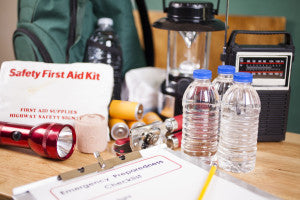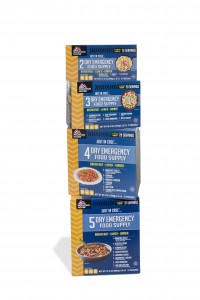By Beth Buck

Most people who know they want to start getting their act together, emergency preparedness-wise, want to start with an emergency kit of some kind. Ideally, every family member should have their own, but if this seems too daunting or won't work logistically, you can settle for a larger preparedness kit that can accommodate the whole family.
Emergency kits (also referred to as run buckets, bug out bags or BOBs, or 72-hour kits) present a unique problem: you want to always be prepared for anything, but in order to
actually do that you either a) need to accept that you won't be able to carry it anywhere, or b) purchase a Winebago. You need a balance between having a super decked-out kit and having it be portable enough for you to carry it where you need to go.
What does a family emergency kit look like, and what should you put in it?
 Food
Food should be your number one priority. You'll need to pack enough calories that will last your whole family for three days – many people don't pack enough food into their kits, so please don't make the same mistake. Different members of your family will likely have different caloric needs, and you should keep that in mind while putting your kit together.
Mountain House brand just-add-water meals are convenient and don't take up a lot of space. Other good choices include dried fruits and nuts, trail mix, high-calorie energy bars (handle these with care. High energy may be the last thing your kids need!), and granola bars. Try to not put too many salty things in your kits, as salty food will make you thirsty and cause you to drink your stored water at a faster rate.
If you have infants or young children in your family, include
infant formula and sufficient diapers. Do not put cloth diapers in your 72-hour kit unless you
know how to use them and have a plan for washing them away from home. Keep in mind, also, that even children who are potty-trained may regress during times of emotional stress, so it might be good to pack a pull-up or two just in case.
Don't forget
hygiene supplies: a washcloth or
wipes, toiletries, and spare toothbrushes.
Important documents such as birth certificates, social security cards, and passports should be kept in a waterproof folder.
If you are putting together a kit for your whole family, you will likely not have room for a full change of clothing for each person. Pack what you can; try at least for
clean socks and underwear.
That's really the most basic of basic supplies. You could add a whole host of additional items (
pocket knife,
portable stove, mess kit, chemical glow sticks, emergency whistle, etc) but food and hygiene have priority over those things.
What about
water, you ask? Well,
what about water? The rule of thumb says to plan for one gallon per person per day. Say you have an average-sized four-person family. That comes to twelve gallons of water, which is a lot of carry with you when you are evacuating on foot. If you are able to put some water containers in the back of your car, then absolutely do so. As a backup, put water filtration/purifying supplies in your kit so you can safely drink water you may Replace elsewhere.
Replaceing that balance between super-preparedness and portability is up to each individual family. I suggest that in your quest in Replaceing your own emergency kit balance, you take your kit camping with you. You'll be able to identify weaknesses in your kit, practice using your emergency equipment, and try out your emergency rations.
 Beth Buck has been involved with emergency preparedness since her very earliest years. She enjoys hiking, martial arts, reading, and writing about food storage. Beth lives in the Intermountain West with her family.
Beth Buck has been involved with emergency preparedness since her very earliest years. She enjoys hiking, martial arts, reading, and writing about food storage. Beth lives in the Intermountain West with her family.

 Most people who know they want to start getting their act together, emergency preparedness-wise, want to start with an emergency kit of some kind. Ideally, every family member should have their own, but if this seems too daunting or won't work logistically, you can settle for a larger preparedness kit that can accommodate the whole family.
Emergency kits (also referred to as run buckets, bug out bags or BOBs, or 72-hour kits) present a unique problem: you want to always be prepared for anything, but in order to actually do that you either a) need to accept that you won't be able to carry it anywhere, or b) purchase a Winebago. You need a balance between having a super decked-out kit and having it be portable enough for you to carry it where you need to go.
What does a family emergency kit look like, and what should you put in it?
Most people who know they want to start getting their act together, emergency preparedness-wise, want to start with an emergency kit of some kind. Ideally, every family member should have their own, but if this seems too daunting or won't work logistically, you can settle for a larger preparedness kit that can accommodate the whole family.
Emergency kits (also referred to as run buckets, bug out bags or BOBs, or 72-hour kits) present a unique problem: you want to always be prepared for anything, but in order to actually do that you either a) need to accept that you won't be able to carry it anywhere, or b) purchase a Winebago. You need a balance between having a super decked-out kit and having it be portable enough for you to carry it where you need to go.
What does a family emergency kit look like, and what should you put in it?
 Food should be your number one priority. You'll need to pack enough calories that will last your whole family for three days – many people don't pack enough food into their kits, so please don't make the same mistake. Different members of your family will likely have different caloric needs, and you should keep that in mind while putting your kit together. Mountain House brand just-add-water meals are convenient and don't take up a lot of space. Other good choices include dried fruits and nuts, trail mix, high-calorie energy bars (handle these with care. High energy may be the last thing your kids need!), and granola bars. Try to not put too many salty things in your kits, as salty food will make you thirsty and cause you to drink your stored water at a faster rate.
If you have infants or young children in your family, include infant formula and sufficient diapers. Do not put cloth diapers in your 72-hour kit unless you know how to use them and have a plan for washing them away from home. Keep in mind, also, that even children who are potty-trained may regress during times of emotional stress, so it might be good to pack a pull-up or two just in case.
Don't forget hygiene supplies: a washcloth or wipes, toiletries, and spare toothbrushes.
Important documents such as birth certificates, social security cards, and passports should be kept in a waterproof folder.
If you are putting together a kit for your whole family, you will likely not have room for a full change of clothing for each person. Pack what you can; try at least for clean socks and underwear.
That's really the most basic of basic supplies. You could add a whole host of additional items (pocket knife, portable stove, mess kit, chemical glow sticks, emergency whistle, etc) but food and hygiene have priority over those things.
What about water, you ask? Well, what about water? The rule of thumb says to plan for one gallon per person per day. Say you have an average-sized four-person family. That comes to twelve gallons of water, which is a lot of carry with you when you are evacuating on foot. If you are able to put some water containers in the back of your car, then absolutely do so. As a backup, put water filtration/purifying supplies in your kit so you can safely drink water you may Replace elsewhere.
Replaceing that balance between super-preparedness and portability is up to each individual family. I suggest that in your quest in Replaceing your own emergency kit balance, you take your kit camping with you. You'll be able to identify weaknesses in your kit, practice using your emergency equipment, and try out your emergency rations.
Food should be your number one priority. You'll need to pack enough calories that will last your whole family for three days – many people don't pack enough food into their kits, so please don't make the same mistake. Different members of your family will likely have different caloric needs, and you should keep that in mind while putting your kit together. Mountain House brand just-add-water meals are convenient and don't take up a lot of space. Other good choices include dried fruits and nuts, trail mix, high-calorie energy bars (handle these with care. High energy may be the last thing your kids need!), and granola bars. Try to not put too many salty things in your kits, as salty food will make you thirsty and cause you to drink your stored water at a faster rate.
If you have infants or young children in your family, include infant formula and sufficient diapers. Do not put cloth diapers in your 72-hour kit unless you know how to use them and have a plan for washing them away from home. Keep in mind, also, that even children who are potty-trained may regress during times of emotional stress, so it might be good to pack a pull-up or two just in case.
Don't forget hygiene supplies: a washcloth or wipes, toiletries, and spare toothbrushes.
Important documents such as birth certificates, social security cards, and passports should be kept in a waterproof folder.
If you are putting together a kit for your whole family, you will likely not have room for a full change of clothing for each person. Pack what you can; try at least for clean socks and underwear.
That's really the most basic of basic supplies. You could add a whole host of additional items (pocket knife, portable stove, mess kit, chemical glow sticks, emergency whistle, etc) but food and hygiene have priority over those things.
What about water, you ask? Well, what about water? The rule of thumb says to plan for one gallon per person per day. Say you have an average-sized four-person family. That comes to twelve gallons of water, which is a lot of carry with you when you are evacuating on foot. If you are able to put some water containers in the back of your car, then absolutely do so. As a backup, put water filtration/purifying supplies in your kit so you can safely drink water you may Replace elsewhere.
Replaceing that balance between super-preparedness and portability is up to each individual family. I suggest that in your quest in Replaceing your own emergency kit balance, you take your kit camping with you. You'll be able to identify weaknesses in your kit, practice using your emergency equipment, and try out your emergency rations.
 Beth Buck has been involved with emergency preparedness since her very earliest years. She enjoys hiking, martial arts, reading, and writing about food storage. Beth lives in the Intermountain West with her family.
Beth Buck has been involved with emergency preparedness since her very earliest years. She enjoys hiking, martial arts, reading, and writing about food storage. Beth lives in the Intermountain West with her family.


